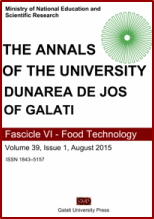Lycopene and β-carotene recovery from fermented tomato waste and their antioxidant activity
Abstract
Waste generated from tomato processing poses disposal challenge even though it is a potential source of bioactive compounds. Acetone/ethanol/hexane mixture was used to recover lycopene and β-carotene from tomato pomace obtained from tomato must fermentation (pH of 4.11, 3.40, 3.20; temperature of 15, 20oC). Tomato must pH and temperature influenced (P<0.05) both lycopene and β-carotene recovery from the pomace. The highest total antioxidant activity and reducing power values were obtained from the tomato pomace of must pH 3.20, and fermented at 20ᵒC. Tomato pomace from winemaking is a rich source of the bioactive compounds, lycopene and β-carotene, and possess substantial levels of antioxidant activity.


